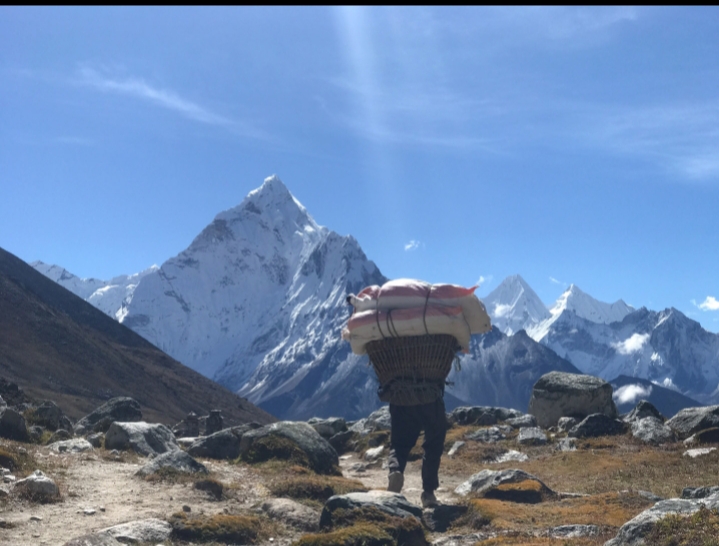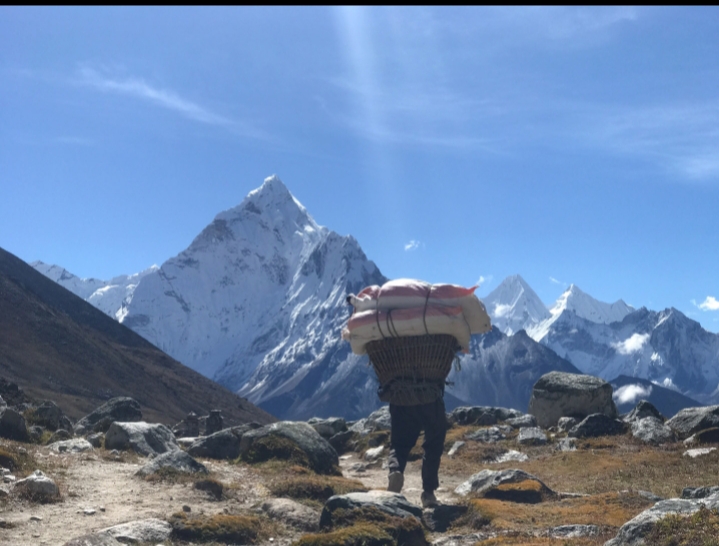Residing in the mountain region of Solukhumbu district in Nepal is a remarkable ethnic community known as the Sherpa. Their presence is particularly prominent in the enchanting Pangboche Village.
They are recognized as the high-altitude porters, and climbers for their incredible strength and endurance capabilities of carrying heavy loads through the challenging trails of the giant mountains.
Interestingly, the term “Sherpa” originally means the “people from the East”, pronounced as “Sharwa” by the Sherpa community people themselves.
Lifestyle and History of Sherpa
Going back to the Sherpa history rooted in Tibet, they migrated to Nepal in the 15th century while trading goods between Nepal and Tibet. Tibet is a small territory of China sharing its border with Nepal, leading to similarities between the Tibetan and Sherpa language and culture.
For over the centuries, the Sherpa people have led a challenging lifestyle, surviving in the mountains by trading goods such as salt, wool and rice between Nepal and Tibet. Besides, they also raise yaks, farm potatoes, buckwheat, and barley to sustain their families.
Inspiring stories of the Sherpa family
The Sherpa men’s attention and interest towards mountain climbing began to grow gradually after the historic first ascent of Mount Everest on May 29, 1953 by Tenzing Norgay Sherpa and Sir Edmund Hillary. Likewise, the feat propelled the Sherpa’s into the spotlight, and they became known as the mountain heroes.
As a result, of the event the Sherpa men started working as the porters, trekkers, and climbers in Everest Base Camp trek, Annapurna Base Camp Trek and Langtang trekking routes to support their families.
Sadly, many stories of the Sherpa families have resulted in numerous heartbreaking losses of their loved ones during the expeditions due to the dangerous nature of the mountain. The working lives of Sherpa men posed a significant risk to both themselves and their families.
However, carrying the heavy load in the mountains was the only viable means for them to ease the burden of feeding their families and sustaining their household expenses.
From Climbing Sherpa’s to Commercial Trekking Guide
As the tourism industry in Nepal began to expand, Namche became the most developed village in the mountains, followed closely by the Everest Base Camp trek.
The mountain Sherpa’s quickly adapted to the changing market situations by opening up their homes to travelers, as they realized that hosting travelers would be a lucrative way to earn money without risking their lives on the mountains.
Similarly, they started registering their own travel agency, opened teahouses in the Everest regions, and became trekking guides. As a result, Everest has become the most popular trekking destination in Nepal, attracting thousands of visitors from all over the world each year.
Along with that, the trails of the Everest Base Camp trek can be attempted by all individuals with good physical condition. Perhaps, it is important to note that it’s still remains a difficult and dangerous journey due to its altitude.
Altitude sickness is a major concern in the region causing serious threat to trekkers, even those who are physically fit. However, Sherpa’s are the best-known people for the prevention of high altitude sickness as they grew up in that environment.
The Faith of Sherpa relies on the Mountains
The Sherpa community reveres the mountains as sacred entities that provide them withthe sustenance, shelter, and protection from the harsh elements during their expedition journey.
They believe in the mountain as the living beings who have its own spirit or deity that they must respect and appease through offering and prayers. The spiritual connection to the mountains is an integral part of the Sherpa culture and has been passed down from generation to generation for over the centuries.
In addition to this, they are more concerned about the growing impact of climate change on their professions. The melting of snow and glaciers due to rising temperatures and pollution has been a significant threat to the mountain environment and the tourism industry.
In contrast, it has major consequences for the livelihood of those who depend on the mountains.
Hence, it is advised to travelers to take a comprehensive approach to address the climate change in the region by reducing carbon emission through sustainable practices, developing adaptation strategies to help communities cope up with the impact of climate change.
Ultimately, the action must be taken to ensure that the trekking in mountains remains a sustainable resource for generations to come.
Conclusion
Therefore, despite the challenges they face, the Sherpa ethnic people continue to thrive and prosper in Nepal’s mountainous regions, making them a truly remarkable and admirable community. Their strength and endurance had made them an integral part of Nepal’s tourism industry.
In addition, although the term “Sherpa” has become synonymous with the high-altitude porters and guides, it is important to note that not all porters, guides and climbers are Sherpa’s.
You can also witness the people from different ethnic groups like Brahmin and Chhetris who are now engaged in the occupation.

